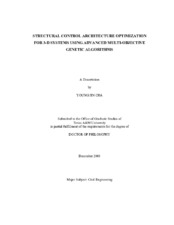Structural control Architecture Optimization for 3-D Systems Using Advanced Multi-Objective Genetic Algorithms
Abstract
The architectures of the control devices in active control algorithm are an
important fact in civil structural buildings. Traditional research has limitations in finding
the optimal architecture of control devices such as using predefined numbers or
locations of sensors and dampers within the 2-and 3-dimensional (3-D) model of the
structure. Previous research using single-objective optimization only provides limited
data for defining the architecture of sensors and control devices. The Linear Quadratic
Gaussian (LQG) control algorithm is used as the active control strategy. The American
Society of Civil Engineers (ASCE) control benchmark building definition is used to
develop the building system model. The proposed gene manipulation genetic algorithm
(GMGA) determines the near-optimal Pareto fronts which consist of varying numbers
and locations of sensors and control devices for controlling the ASCE benchmark
building by considering multi-objectives such as interstory drift and minimizing the
number of the control devices.
The proposed GMGA reduced the central processing unit (CPU) run time and
produced more optimal Pareto fronts for the 2-D and 3-D 20-story building models. Using the GMGA provided several benefits: (1) the possibility to apply any presuggested
multi-objective optimization mechanism; (2) the availability to perform a
objective optimization problem; (3) the adoptability of the diverse encoding provided by
the GA; (4) the possibility of including the engineering judgment in generating the next
generation population by using a gene creation mechanisms; and (5) the flexibility of the
gene creation mechanism in applying and changing the mechanism dependent on
optimization problem.
The near-optimal Pareto fronts obtained offer the structural engineer a diverse
choice in designing control system and installing the control devices. The locations and
numbers of the dampers and sensors in each story are highly dependent on the sensor
locations. By providing near-Pareto fronts of possible solutions to the engineer that also
consider diverse earthquakes, the engineer can get normalized patterns of architectures
of control devices and sensors about random earthquakes.
Citation
Cha, Young Jin (2008). Structural control Architecture Optimization for 3-D Systems Using Advanced Multi-Objective Genetic Algorithms. Doctoral dissertation, Texas A&M University. Available electronically from https : / /hdl .handle .net /1969 .1 /ETD -TAMU -2008 -12 -208.


